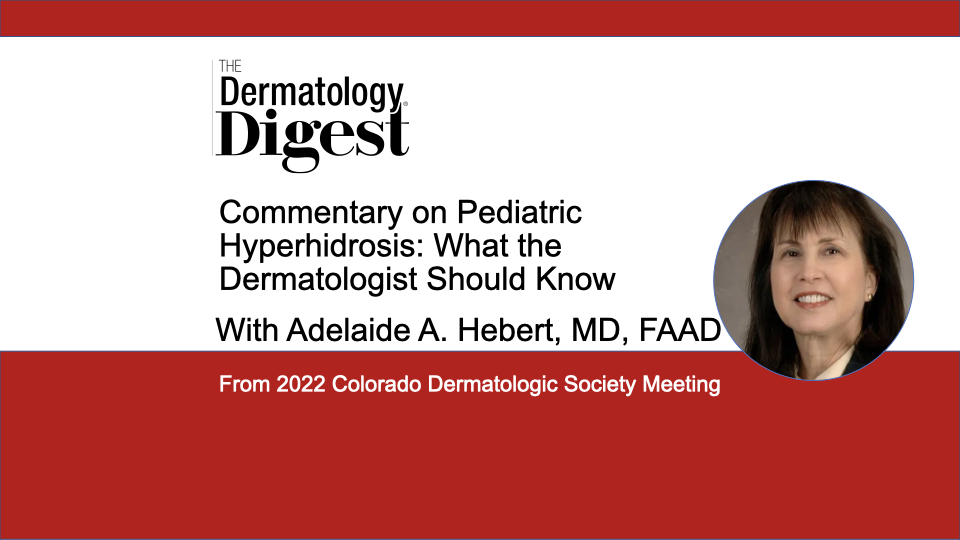Dr. Adelaide Hebert discusses the importance of recognizing and treating hyperhidrosis in children with available oral and topical treatment options.
Adelaide A. Hebert, MD, FAAD, Professor of Dermatology and Pediatric Dermatology, McGovern Medical School at UTHealth Houston
“Because [hyperhidrosis] often starts in the childhood population, I think it’s really important that it’s recognized. It’s very unfortunate that many medical practitioners—and I mean, not just physicians, but nurses, PAs, etc.—don’t really get a lecture in their training about hyperhidrosis, so they really don’t know that it’s a true entity, a true diagnosis with potential therapeutic options, and as a result, we spend a lot of time just educating our patients,” said Adelaide A. Hebert, MD, FAAD, who presented “Pediatric Hyperhidrosis: What the Dermatologist Should Know” at the 2022 Colorado Dermatologic Society Meeting.
“I probably have one of the only sweating clinics in the city of Houston, the fourth largest city in the United States. We see people from all over. I do see both adults and pediatric patients in that particular clinic. And these patients are often very grateful to find someone who actually knows about sweating, is interested in their problem, is unafraid to shake their hand and really talk to them in depth about how we can make not only their sweating better their life better.”
According to Dr. Hebert, about 2% to 4% of the population is affected by hyperhidrosis. In children, it becomes apparent once they start school. Wet hands ruin artwork; other kids don’t want to hold their hands when crossing the street, she said.
“There does seem to be a genetic component. Some patients have a strong family history, either a sibling or parent that has it. It’s not something that’s talked about too readily. It’s not like having blue eyes or red hair… but it’s a little bit more quietly discussed if discussed at all.”
Fortunately, dermatologists have a variety of therapies—systemic and topical—that they can prescribe depending on their patient’s individual needs, said Dr. Hebert.
Glycopyrrolate, an oral medication available in a liquid form, is FDA approved for drooling in cerebral palsy patients as young as three years of age but also works well to control sweating, she said.
“We piggyback on that, if you will, to reassure parents the FDA has approved it… It will work to dry up any bodily secretions and sweating is one of those.”
Glycopyrrolate is generally well tolerated and side effects are mild and can be managed fairly easily, she said.
“…it can give some dry mouth, but we have ways to overcome that. It can occasionally give constipation. We work on diet with fluid intake to accommodate that side effect. But most patients find glycopyrrolate an excellent remedy for their hyperhidrosis.”
One benefit to children is that glycopyrrolate can be used on an as-needed basis, so if they are on break from school, they don’t have to take it, said Dr. Hebert.
“Most of our patients are very compliant with their glycopyrrolate because they find it makes such a difference in their life. They’re really willing to continue on that.”
Another oral option is oxybutynin, which is primarily used for bed wetting, said Dr. Hebert.
“Many pediatricians and urologists prescribe this. Parents are not afraid of it because they have probably heard of it with a friend, colleague, cousin—somebody in the family might have required that medicine. [It] works very well, and patients tolerate this without great difficulty.”
Both glycopyrrolate and oxybutynin are covered by formulary plans and insurance, said Dr. Hebert.
“So it’s easy for the patient to get those medicines from a local pharmacy and use them on a regular, ongoing basis.”
A newer medicine, glycopyrronium topical wipes, 2.4%, is approved for patients with hyperhidrosis who are 9 years of age and older, said Dr. Hebert.
“They simply wipe that armpit area at night, then thoughtfully discard it so small children and pets don’t get to it. It works very well. We’re very fortunate to have it down to nine years of age.”
There are new products in the pipeline too, according to Dr. Hebert.
“We have some other new products that we’ve studied but have not yet received FDA approval, also in the topical realm for children down to 9 years of age, so very exciting things to look forward to in the arena of hyperhidrosis.”
References:
Hyperhidrosis:
- American Academy of Dermatology. “Hyperhidrosis.” Accessed December 27, 2022. https://www.aad.org/conditions/dermatitis/hyperhidrosis.
Glycopyrrolate:
- Drugs.com. “Glycopyrrolate.” Accessed December 27, 2022. https://www.drugs.com/monograph/glycopyrrolate.html.
Oxybutynin:
- Drugs.com. “Oxybutynin.” Accessed December 27, 2022. https://www.drugs.com/oxybutynin.html.
Glycopyrronium topical wipes:
- U.S. Food and Drug Administration. “Glycopyrronium.” Accessed December 27, 2022. https://www.accessdata.fda.gov/drugsatfda_docs/label/2017/209462s000lbl.pdf.


